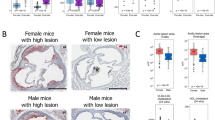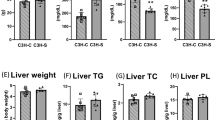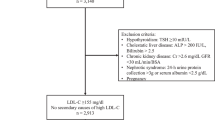Abstract
Familial combined hyperlipidaemia (FCHL) is a common, multifactorial disorder associated with elevated levels of plasma triglyceride, cholesterol, or both1–3. A characteristic feature is increased secretion of very low density lipoproteins (VLDL) and apolipoprotein B (apoB; refs 3,4). Although FCHL is the most common cause of premature coronary artery disease (CAD), accounting for over 10% of cases, its aetiology remains largely unknown3–6. One powerful approach to the dissection of complex genetic traits involves the use of animal models7. We have identified a mouse strain, HcB-19/Dem (HcB-19), which exhibits hypertriglyceridaemia, hypercholesterolaemia and elevated levels of plasma apoB. Like FCHL patients, HcB-19 mice also exhibit increased secretion of triglyceride-rich lipoproteins, and their hyperlipidaemia becomes progressively more severe with age. It is likely that the hyperlipidaemia results from a mutation of a novel gene that arose during development of strain HcB-19. We mapped the hyperlipidaemia gene (Hyplip 1) to the distal portion of mouse chromosome 3. This region is syntenic to human chromosome 1q21–q23, which has recently been shown to harbour a gene associated with FCHL in families from a Finnish isolate (see accompanying manuscript by Pajukanta et al., ref. 8).
This is a preview of subscription content, access via your institution
Access options
Subscribe to this journal
Receive 12 print issues and online access
$209.00 per year
only $17.42 per issue
Buy this article
- Purchase on Springer Link
- Instant access to full article PDF
Prices may be subject to local taxes which are calculated during checkout
Similar content being viewed by others
References
Goldstein, J.L., Schrott, H.G., Hazzard, W.R., Bierman, E.L. & Motulsky, A.G. Hyperlipidemia in coronary heart disease II. Genetic analysis of lipid levels in 176 families and delineation of a new inherited disorder, combined hyperlipidemia. J. Clin. Invest. 52, 1544–1568 (1973).
Brunzell, J.D. et al. Plasma lipoproteins in familial combined hyperlipidemia and monogenic familial hypertriglyceridemia. J. Lipid Res. 24, 147–155 (1983).
Kwiterovich, P.O. Genetics and molecular biology of familial combined hyperlipidemia. Curr. Opin. Lipidol. 4, 133–143 (1993).
Venjatesan, S., Cullen, P., Pacy, P., Halliday, D. & Scott, S. Stable isotopes show a direct relation between VLDL apoB overproduction and serum triglyceride levels and indicate a metabolically and biochemically coherent basis for familial combined hyperlipidemia. Arterioscler. Thromb. Vasc. 13, 110–118 (1993).
Aitman, T.J. et al. Defects of insulin action on fatty acid and carbohydrate metabolism in familial combined hyperlipidemia. Arterioscler. Thromb. Vasc. Biol. 17, 748–754 (1997).
Pajvkanta, P. et al. No evidence of linkage between familial combined hyperlipidemia and genes encoding lipolytic enzymes in Finnish families. Arterioscler. Thromb. Vasc. Biol. 17, 841–850 (1997).
Silver, L.M. Mouse Genetics Concepts and Applications. 195–263 (Oxford Press, New York, 1995).
Pajukanta, P. et al. Linkage of combined hyperlipidemia to chromosome 1q21–q23. Nature Genet. 18, 367–371 (1998).
Demant, P. & Hart, A.A.M. Recombinant congenic strains: a new tool for analyzing genetic traits determined by more than one gene. Immunogenetics 24, 416–422 (1986).
Groot, P.C. et al. The recombinant congenic strains for analysis of multigenic traits: genetic composition. FASEB J. 6, 2826–2835 (1992).
Collin, G.B., Asada, Y., Varnum, D.S. & Nadeau, J.H. DNA pooling as a quick method of finding candidate linkages in multigenic trait analysis: an example involving susceptibility to germ cell tumors. Mamm. Genome 7, 68–70 (1996).
Falconer, D.S. Introduction to Quantitative Genetics. (Longman, London, 1991).
Welch, C.L. et al. Genetic regulation of cholesterol homeostasis: chromosomal organization of candidate genes. J. Lipid. Res. 37, 1406–1421 (1997).
McGarry, J.D., Woeltje, K.F., Kuwajima, M. & Foster, D.W. Regulation of ketogenesis and the renaissance of carnitine palmitoyltransferase. Diabet Metab. Rev. 5, 271–284 (1989).
Valera, A. et al. Overexpression of mitochondrial 3-hydroxy-3-methylglutaryl-CoA synthase in transgenic mice causes hepatic hyperketogenesis. J. Biol. Chem. 269, 6267–6270 (1994).
Hedrick, C.C., Castellani, L.W., Warden, C.H., Puppione, D.L. & Lusis, A.J. Influence of mouse apolipoprotein A-II on plasma lipoproteins in transgenic mice. J. Biol. Chem. 269, 20676–20682 (1993).
Doolittle, M.H., Wong, H., Davis, R.C. & Schotz, M.C. Synthesis of hepatic lipase in liver and extrahepatic tissues. J. Lipid Res. 28, 1326–1333 (1993).
Khan, B.V., Fungwe, T.V., Wilcox, H.G. & Heimberg, M. Cholesterol is required for the secretion of the very low density lipoprotein: in vivo studies. Biochim. Biophys. Acta 1044, 297–304 (1990).
Author information
Authors and Affiliations
Corresponding author
Rights and permissions
About this article
Cite this article
Castellani, L., Weinreb, A., Bodnar, J. et al. Mapping a gene for combined hyperlipidaemia in a mutant mouse strain. Nat Genet 18, 374–377 (1998). https://doi.org/10.1038/ng0498-374
Received:
Accepted:
Issue Date:
DOI: https://doi.org/10.1038/ng0498-374
This article is cited by
-
Genetic determinants of atherosclerosis, obesity, and energy balance in consomic mice
Mammalian Genome (2014)
-
Inflammatory serum proteome pattern in mice fed a high-fat diet
Amino Acids (2013)
-
Hepatocellular carcinoma in Txnip-deficient mice
Oncogene (2006)
-
Genetic susceptibility to coronary artery disease: from promise to progress
Nature Reviews Genetics (2006)
-
An autosomal genomic scan for loci linked to type 2 diabetes in northern Han Chinese
Journal of Molecular Medicine (2005)



